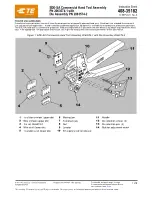
-28-
7.3
Clamping force depending on the material
To determine the required clamping force of the joint, the properties of the timbers to be joined and the
moisture content of the timber must be taken into account.
In the following cases, a low to medium clamping force is required = position Mini to Midi on the gauge:
-
Jig: small to medium model (models 50 and 80)
-
Small cross section of timbers
-
Short dovetail
-
Dry timber
-
Glued laminated timber
In the following cases, a medium to high clamping force is required = position Midi to Maxi on the gauge:
-
Jig: medium to large model (models 80-120-160)
-
Medium or large cross section of timbers
-
Medium or long dovetails
-
Moist to wet timber
-
Solid timber
If the pin is inserted by hand into the pin socket, resistance will be felt before the joint is assembled flush. The
pin is then not yet at the bottom of the pin socket and protrudes upwards by a few millimetres. This projection is
called the "K" value and corresponds to the clamping force (Fig. 11).
On the basis of our practical experience, we were able to determine the following guide values in this respect,
which can vary depending on the working method and situation and do not replace trial cuttings.
Jig model
Small jig models No. 50 Medium jig models No.
80
Large jig models No.
120 - 160
Type of material
"K" value in mm = projection of the pin inserted
in the pin socket by hand (prior to driving in under exertion of force)
Glued laminated timber
(spruce/fir)
Timber moisture approx.
12 %
~2 to ~4 mm
~3 to ~7 mm
~5 to ~8 mm
Duo/trio beam (made of
2 or 3 layers of glued
spruce/fir)
Timber moisture approx.
15 %
~2 to ~5 mm
~2 to ~8 mm
~2 to ~9 mm
Solid timber (spruce/fir)
Timber moisture equal to
or less than 15 %
~3 to ~6 mm
~4 to ~8 mm
~5 to ~10 mm
Solid timber (spruce/fir)
Timber
moisture
between 15 % and 30 %
~3 to ~6 mm
~4 to ~9 mm
~5 to ~12 mm
















































